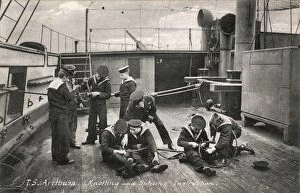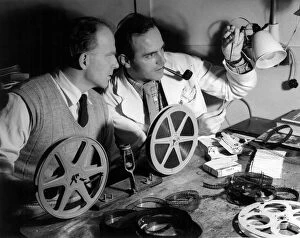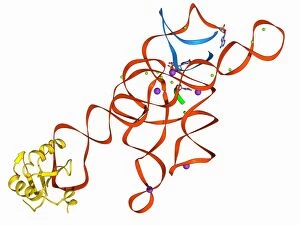Splicing Collection
"Splicing: A Journey through Knotting Class, Naval Training, and Medical Breakthroughs" Step aboard the Training Ship Arethusa in Greenhithe, Kent
For sale as Licensed Images
Choose your image, Select your licence and Download the media
"Splicing: A Journey through Knotting Class, Naval Training, and Medical Breakthroughs" Step aboard the Training Ship Arethusa in Greenhithe, Kent, where young sailors learned the art ropes. The skillful hands of these future seafarers would later find themselves on HMS Tartar, expertly joining strands to ensure the Royal Navy's strength. Meanwhile, at Queen Mary's Hospital in Sidcup, Kent, doctors delved into a different kind of splicing. Their groundbreaking film chronicled the life-saving techniques used to mend wounded soldiers during war times. On HMS Bacchante, Princes Albert Victor and George honed their naval skills while witnessing blue jackets deftly splice ropes. These moments shaped their understanding of seamanship and leadership. Away from the sea but still connected by threads of knowledge, gardening enthusiasts reveled in colorful lithographs depicting plants being carefully grafted together—a form of horticultural splicing that brought forth new varieties and beauty. In 1905 at The Royal Naval College in Osborne, aspiring officers were taught not only navigation but also how to splice cables—an essential task for maintaining communication lines across vast oceans. History was forever marked on July 25th, 1865 when disaster struck onboard the Great Eastern. Undeterred by setbacks after an accident with a cable splice gone wrong earlier that day; courageous crew members rallied together to repair it—showcasing resilience amidst adversity. A snapshot from 1896 captures blue jackets hard at work on board HMS Majestic as they meticulously splice ropes—a testament to teamwork and precision within the mighty battleship's confines. During World War I came another chapter in splicing history as boys were trained for service in the navy. They learned not only how to handle weapons but also acquired vital skills like rope-splicing—preparing them for life at sea amidst turbulent times. Beyond physical realms lies a fascinating realm of molecular splicing.

















